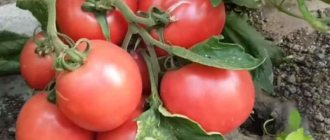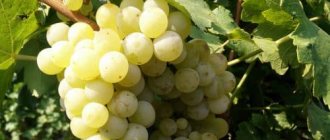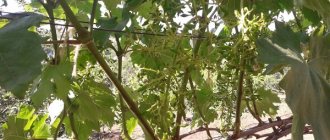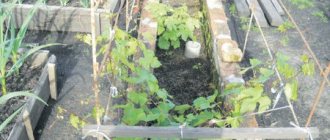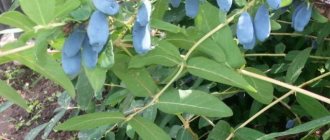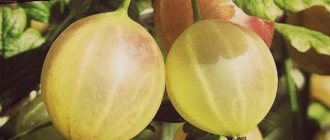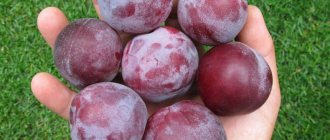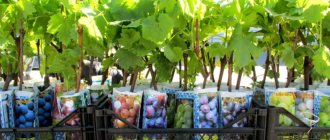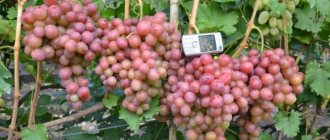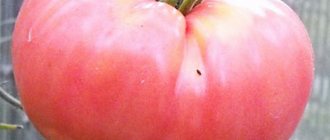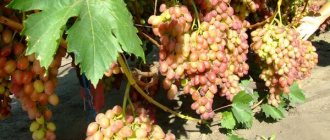Fruits and berries » Grapes
0
1004
Article rating
Kira Stoletova
Minsk pink grapes have beneficial qualities and dietary properties to a greater extent than other varieties. It is based on varieties of the metal variety.
Description of Minsk pink grapes
Advantages and disadvantages
Advantages:
- Ripening period is early.
- Good resistance to some fungal diseases.
- High frost resistance.
- Unusual strawberry taste.
- Good survival rate of cuttings, low maintenance.
- High sugar content and juiciness of berries.
Flaws:
- Susceptibility to gray rot.
- Relatively small size of bunches and berries.
- Poor transportability.
- The need for attention to rationing of bushes to increase yields.
Grapes "Amursky"
- General characteristics of the variety
- Features of cultivation
- Care
- Reviews
- Video on the topic
Many gardeners do not plant grapes on their plots because this crop is considered very capricious. She needs serious care and special conditions are required. But there is one unpretentious variety - Amur grapes. It is frost-resistant, easily adapts to different conditions and produces a large harvest with minimal care. Growing Amur grapes is not difficult, but before purchasing it, you need to study the description of the variety, its varieties, advantages and disadvantages.
Many gardeners do not plant grapes on their plots because this crop is considered very capricious. She needs serious care and special conditions are required. But there is one unpretentious variety - Amur grapes. It is frost-resistant, easily adapts to different conditions and produces a large harvest with minimal care. Growing Amur grapes is not difficult, but before purchasing it, you need to study the description of the variety, its varieties, advantages and disadvantages.
Landing
Before you start planting and digging a hole, you need to prepare:
- Drainage (broken brick, crushed stone, gravel).
- Support stake.
- Mineral fertilizers (superphosphate).
- Humus.
- Ash.
Dig a planting hole 70 cm deep and 70 cm wide. Place a 25 cm layer of drainage on the bottom. Add 2-3 buckets of humus, a glass of superphosphate and ½ bucket of ash to the garden soil that will be used for backfilling.
Drive a stake into the center of the hole, fill in the prepared soil and form a hole in it for the seedling. It should be so deep that only 2 eyes stick out above the surface of the earth. The planting hole is filled with water. Growing shoots must be tied to a support.
Trimming . An important point in caring for grapes. The productivity and health of the vine depends on how well it is carried out. The norm of eyes on a vine is from 8 to 12; excess shoots need to be trimmed. Cut out weak branches. Carry out rationing - leave 1-2 bunches on each shoot.
Watering . If the weather is hot, water the sultanas every 3 days. One plant needs at least 4 buckets of water, more water is needed if the soil is sandy. 2 weeks before harvesting, water once every 7 days.
Feeding . In spring and in the first half of summer, grapes need fertilizing containing nitrogen; organic fertilizers will not hurt either. In the second half of summer, the plant needs potassium and phosphorus to form fruits. Nitrogen fertilizing is stopped.
In addition to root fertilizing with mineral and organic fertilizers, foliar fertilizing is needed. Conduct them during the flowering period of grapes. Use the drug Ovary. Use the stimulant gibberellin to increase the size of the berries and increase the density of the grape cluster.
- Ridomil Gold;
- Strobe.
How to prepare a planting hole for planting in autumn
There are several stages:
- You need to dig a landing race, its diameter should be a hundred centimeters, and its depth should be seventy to eighty centimeters.
- Fertile soil from the top of the soil must be poured separately to prepare a nutrient mixture.
- At the very bottom of the planting hole, you need to lay a drainage layer, this will protect the bush from rotting.
- After the drainage layer, it is necessary to lay a fertile layer. To do this, you need to mix fertile soil with organic humus or rotted compost. It is also recommended to add five kilograms of wood ash and five hundred grams of azofoska. Wood ash must come from clean wood, that is, not painted, not glued, not varnished.
- You need to dig a landing race, its diameter should be a hundred centimeters, and its depth should be seventy to eighty centimeters.
- Fertile soil from the top of the soil must be poured separately to prepare a nutrient mixture.
- At the very bottom of the planting hole, you need to lay a drainage layer, this will protect the bush from rotting.
- After the drainage layer, it is necessary to lay a fertile layer. To do this, you need to mix fertile soil with organic humus or rotted compost. It is also recommended to add five kilograms of wood ash and five hundred grams of azofoska. Wood ash must come from clean wood, that is, not painted, not glued, not varnished.
Description
The Minsk Pink grape variety was bred by Belarusian breeders in 1952 by pollinating the plant with pollen of hybrid varieties. It is most suitable for cultivation in central Russia and has a sufficient degree of frost resistance - down to -30°C. It is considered an early variety, and its ripening period is 100–110 days.
This variety is characterized by a vigorous vine with a powerful stem and a medium degree of foliage. The medium-sized, rounded leaves have several lobes with sharp, narrow teeth.
The inflorescences are bisexual, which means that they have pistils and stamens. The clusters have a canonical shape. The berries in them fit tightly to each other, thereby giving the clusters a neat appearance. One bunch can weigh from 200 to 270 g. The berries themselves are medium in size - up to 2-3 cm in diameter, weighing up to 3 g. The peel is quite thin, elastic, and has a delicate pink-violet hue. The pulp is juicy with a small number of seeds, rich pink in color.
The grapes on the vine ripen together. You can harvest up to 4 kg of harvest from one plant. Due to its high resistance to low temperatures, the Minsk Pink variety does not require covering. Grapes have up to 25% sugar content, so the berries taste very sweet and juicy. This variety is considered universal because it is perfect for fresh consumption, it is especially useful for children, and is also considered suitable for making sweet, weak wines.
Many gardeners pay attention to the Minsk Pink variety because of its undeniable advantages.
Characteristics of the variety
Minsk pink grapes were bred by plant breeders from the Institute of Biology Savchenko, Govorukhin and Rybakov in Belarus in 1952. Officially included in the State Register of Tree and Shrub Species in 2005. It is listed in the register under the name “Minsk hybrid”.
The variety has a number of distinctive qualities:
- frost resistance (withstands up to -30ºС);
- annual fruiting;
- good survival rate;
- early ripening;
- resistance to fungal diseases;
- wonderful taste.
Full ripening occurs 3 months after bud break. The harvest begins in the first days of September. The yield reaches 3.5 kg per bush.
- frost resistance (withstands up to -30ºС);
- annual fruiting;
- good survival rate;
- early ripening;
- resistance to fungal diseases;
- wonderful taste.
Detailed description
The history of this variety dates back to 1952, when Belarusian breeders Savchenko, Govorukhina, Rybakova, together with the Institute of Biology of the Academy of Sciences of the Belarusian SSR, pollinated a mixture of pollen from several different hybrid varieties of metallic grapes. Their experiment turned out to be successful: the brainchild turned out to be frost-resistant, relatively resistant to most fungal diseases, and also tasty and aromatic.
Subsequently, in 2005, “Minsk pink” was officially included in the State Register of Tree and Shrub Species of the Republic of Belarus, where it is still listed today under the name “Minsk hybrid”.
Characteristics of the variety
Minsk pink grapes were bred by plant breeders from the Institute of Biology Savchenko, Govorukhin and Rybakov in Belarus in 1952. Officially included in the State Register of Tree and Shrub Species in 2005. It is listed in the register under the name “Minsk hybrid”.
The variety has a number of distinctive qualities:
- frost resistance (withstands up to -30ºС);
- annual fruiting;
- good survival rate;
- early ripening;
- resistance to fungal diseases;
- wonderful taste.
Full ripening occurs 3 months after bud break. The harvest begins in the first days of September. The yield reaches 3.5 kg per bush.
Description of the vine
This crop is grown throughout the country, in different climatic conditions, due to its qualities and universal purpose:
- tall, vigorous bush;
- shoots ripen well;
- leaf is medium, rounded;
- flowers are bisexual;
Fruiting of shoots reaches 55-60%. There are 1-2 inflorescences on the shoot. The bisexuality of flowers ensures high yields annually.
The leaves of the Minsk pink grape have sharp teeth along the edges, three-fingered and slightly rugged. There are irregularities on their outer side; on the inner surface they are covered with hairs with a slight whitish coating.
Because of the beauty of the vines and leaves, the bushes are used in landscape design, to decorate summer gazebos or fences.
Description of the fruit brush
The fruit cluster of ripe Minsky grapes looks attractive. According to the description of the pink Minsky grape variety:
- the bunch is evenly filled;
- high density;
- bunch weight up to 300 g;
- pink colour;
- berry weight 2.8-3 g;
- the skin is dense;
- the flesh is pink, slimy.
Sugar content reaches 25%, with low acidity. The pulp has a balanced taste, leaving a pleasant strawberry aftertaste. The skin crunches pleasantly on the teeth.
Disadvantages of the variety
Berries do not tolerate transportation well
This variety has a number of disadvantages. These include susceptibility to viral diseases and gray rot. It does not tolerate long-term transportation well, the berries become wrinkled and begin to rot. It is better to sell grapes in the area where they are grown.
The size of the ripened berries is small; when overripe, the cluster is positioned towards peas. The harvest is not stored on the vine; it is harvested immediately.
The tendency to overload requires increased attention when forming bushes and when pruning them.
Eating
This hybrid has a high sugar accumulation, and is used to produce premium wine, which has an excellent taste and a rich, unique aroma.
Related article: Other inhibitory substances - Conditions for the development and activity of lactic bacteria in wine
The Belarusian subspecies serves as an excellent raw material for freshly squeezed juices or for storing them for the winter. It will be of great benefit when consumed fresh due to its content, rich in vitamins, trace elements and minerals.
In the confectionery industry, it is used to create confitures, jellies and marmalades. It is used in baking as a natural flavoring.
According to studies, this species is more beneficial than lighter hybrids. It has anticarcinogenic and antioxidant effects on the human body. Rozovy Minsk variety has an invaluable healing effect on the human heart and blood vessels.
Characteristics
“Minsky pink” is versatile; its berries are good both fresh and processed. The variety is widely used in confectionery: confiture, jelly, marmalade are prepared from it, and it is also used as a natural flavoring. Due to its high sugar content (25 - 27%), these grapes are an excellent raw material for the production of wine or various drinks.
Ripening period
The “Minsk pink” variety is classified as an early grape variety. The duration of the ripening period from the beginning of the growing season to the complete ripening of the brushes is 105 – 110 days. In its homeland, Belarus, the variety manages to ripen by the beginning of September.
Bush
The grape bush is tall and vigorous, the shoots ripen well (up to 3 meters per season), while their fruiting rate is 55 - 60%. The variety requires strong support and correct formation of the bush.
Reference! The aesthetic appeal of leaves and vines has not gone unnoticed by landscape designers: “Minsk pink” is widely used to decorate arbors, fences, arches and walls.
The flowers of the variety are bisexual, which ensures a regular good harvest. This can create some problems: the variety is prone to overloading the bushes with the harvest; each shoot has 1–3 inflorescences.
The leaves are medium-sized and round in shape and are decorative: on the outside they are uneven, lumpy, and on the inside they are covered with a light whitish coating. In addition, each of them is decorated with sharp teeth along the edges.
Bunches and berries
The variety's clusters are medium in size, shaped like a cylinder, but evenly filled and dense. The weight of the brush usually reaches 250 - 300 g.
The berries are also not large in size, the weight of each of them is in the range of 2.5 - 3 g. Their shape is round, the color is pink with a slight lilac tint. The pulp is also pink, juicy, slimy; the skin is thin, crunches pleasantly on the teeth when tasting and is easily removed from the pulp in a single bag. The seeds are large, 3–4 pieces in each berry. Berry juice contains high levels of sugar content - 25 - 27 g per 100 g of liquid.
Taste
The taste of “Minsk rose” is unusual, it combines an isabelle taste and a subtle strawberry aftertaste.
Reference! According to recent studies, the “Minsk pink” variety has antioxidant and anti-carcinogenic effects on the human body. This grape is also good for the heart and blood vessels.
Description of the grape variety Minsky Pink
Minsk pink grapes are a unique variety that has universal qualities. This practical grape variety was bred in Belarus in the middle of the last century. Experienced breeders crossed several varieties of hybrids in the form of pollination, and the result was grapes that have a degree of early ripening. After the formation of the first blossoming leaves on a vine branch, approximately 100 to 115 days pass before the harvest of fully ripened berries. This grape variety is extremely popular in the Republic of Belarus. The variety turned out to be completely unpretentious and does not require time and effort to care for.
Properties of grapes
Brief characteristics of the grapes of this variety:
- this variety has a sugar content of 23-26%;
- it has a beautiful cylindrical bunch shape;
- has an approximate bunch weight of about 250 g;
- the berries themselves have a slightly oval and round shape;
- the weight of one berry ranges from 2 to 3 g;
- resistant to frost, which is why it feels good down to -28-30 degrees;
- has a pleasant strawberry flavor.
The leaves of the shrub are of medium size, often three-lobed, with a weak section. It has open cutouts on the sides and a rounded bottom. The tips of the leaves are slightly pointed and narrow. The tops of the leaves have a bubbly coating and the undersides have a bit of hairiness.
The flower itself is bisexual, it has stamens and pistils. In size, ripe bunches grow to medium weight and have an attractive cylindrical shape. The berries on the bunch are tightly located to each other, often because of this they become deformed. The grape bunches have almost the same weight and shape. On average, the weight of one bunch is approximately 250 grams. The berries are medium in size and weigh approximately 2-3 grams each. The pulp is very juicy and slimy, and has a beautiful colorful pink color. The taste of the berries of this grape variety has a very pleasant strawberry flavor. It also has a thin, but very durable skin, although this is not enough for transportation. Grape juice contains 23-26% sugar, it is thanks to this sugar content that this variety is excellently used for fresh consumption, as well as in winemaking for varieties of wines with increased sweetness and wine material.
Remarkable ripening of the vines. Every second shoot bears fruit. Has high productivity. After the berries ripen, they must be immediately cut from the bush, because it cannot hang on a branch for a long time; it becomes overripe. One bush produces approximately 3.5-4 kg of berries. Exceeding the yield standards that characterize this variety leads to the fact that the vine may become deformed, so in order to prevent this from happening and also in order to achieve maximum yield, it is necessary to regulate the number of bunches according to the standards. Otherwise, the yield and appearance of the bunches are significantly reduced; the berries themselves will have different sizes and not all will have time to ripen evenly.
This variety does not need to be covered in winter, as it is frost-resistant and can withstand air temperatures down to -30 degrees.
High level of resistance to any fungal diseases at a level of 2.5-3 points. Often it is enough to perform one or two treatments with an antifungal drug. It is resistant to mildew, moderately resistant to oidium, and like many hybrid varieties, it is not resistant to gray rot, which can simply destroy the entire crop in a matter of days.
Planting and care
Fertile soils, such as black soil, are suitable for planting, but the seedlings can withstand any other soil, which naturally receives various types of fertilizing according to the schedule. Due to the fact that the variety is resistant to frost, planting can be done both in spring and in autumn.
The most common care is carried out for the grape bushes. The bushes have a high ability to overload with crops, so to achieve a high-quality product you need to competently approach the pruning of the vine. At the right time, when the vine is pruned, 5 to 7 buds are left on each branch. This will help remove excess yield, which will be in excess of the norm at the time of harvesting. The vines are also tied up so that the weight of the ripened bunches does not break them under its own weight.
Adult bushes require feeding in the form of various mineral fertilizers two to three times throughout the year. And fertilizing with organic fertilizers in the form of manure and compost is required every two or three years of fruiting. As a rule, young shrubs do not need to be fertilized during the first three years after planting. All this time, he takes the necessary beneficial additives from the fertilizers that were used when planting the young vine.
Comparison with analogues
“Minsk pink” grapes are one of those few varieties of southern culture that can survive at -30ºС. Few surpass him in this indicator. At the same time, such an important indicator for winemaking as the sugar content of “Belarus” is one of the highest among frost-resistant varieties. Let's take a closer look at it in comparison with its main competitors.
| Sign | Variety | |||
| Minsk pink | Sharov's riddle | Amur breakthrough | Alpha | |
| Ripening period | 100 – 110 days | 100-110 days | 110 days | 110 – 145 days |
| Frost resistance | up to -30°С | Up to -34 °C | -40C | -35C |
| Yield per bush | 8-12 kg | 10 kg. | Up to 100 kg | 10-14 kg |
| Bunches | 250-300 g | 300-600 g. | 200 – 400 g | 150 – 250 g |
| Taste | Isabelle taste and subtle strawberry aftertaste. | Strawberry-raspberry | Simple, harmonious | Isabelle flavor |
| Color | pink | Dark blue | Dark blue | Violet |
| Disease resistance | average | weak | High | Above average |
| Shelf life | 1 month | Up to 3 months | Up to 1 month | Up to 2 months |
| Sugar content | 22-25% | 19-22% | 23% | 15 – 16% |
| Acidity | 6 – 7 g/l | 8-10 g/l | 6 – 7 g/l | 10 – 11 g/l |
Grape varieties grown in Belarus
Very early and early ripening grape varieties. The purpose of the variety is indicated, the bunch and berries are described, and the timing of consumption. Advantages and disadvantages of the variety.
Very early ripening grape varieties
- ALESHENKIN
- ZILGA
- ASTRONAUT
- SPACE
- CRYSTAL
- MINSK PINK
- NEW UKRAINIAN EARLY
Early ripening grape varieties
- AGAT DONSKOY
- BIANCA
- BEAUTY OF THE NORTH
- SUPAGA
- TAMBOV WHITE
Loading …
View all polls
Grape varieties. ALESHENKIN
variety .
Features: the bush has great growth vigor, shoot ripening is satisfactory.
The variety is distinguished by high fruitfulness of shoots (suicide variety) - 80%, so it is necessary to carefully carry out green operations: breaking out twin shoots, weak shoots, thinning (1-2 inflorescences are left on a fruitful shoot).
There are an average of 1.8 inflorescences on one fruitful shoot. The load on the bush is 25-35 buds, pruning is 4-6 buds. Flower bisexual
The bunch is medium and large, conical and broadly conical, often branched, medium density, weighing 600 g.
The berry is medium and large (2.3-3.5 g), oval, matte golden. The pulp is juicy, fleshy, spreading. The taste is sweet, without aroma.
Consumption period: August-September.
Advantage: The variety is winter-hardy (-26ºС), high-yielding - 5.5 kg per bush.
Disadvantage: Resistance to gray rot is average, not resistant to mildew. Requires 3-4 preventive treatments against fungal diseases. The variety is characterized by strong pea production and requires annual additional pollination.
ZILGA
The variety is universal. Productivity – 2.5 kg per bush.
Features: the bush has great growth vigor, shoot ripening is very good. Fruitful shoots – 78%. There are an average of 1.4 inflorescences on one fruitful shoot. The load on the bush is 45-55 buds, pruning is 5-7 buds. The flower is bisexual.
The bunch is small and medium, cylindrical with a wing, medium density, weighing 130 g.
The berry is medium (2.1 g), oval, blue, with a bluish bloom. The pulp is slimy, sweet and sour with a sweet aftertaste.
Consumption period: August-September.
Advantage: The variety is winter-hardy (-32ºС), high-yielding - 5.5 kg per bush. Resistant to mildew and gray rot. Requires 1-2 preventive treatments against fungal diseases.
ASTRONAUT
variety , covering variety. Productivity – 2.4 kg per bush.
Features: the bush has great growth vigor, shoots ripen well. The load on the bush is 35-45 buds, pruning is 4-8 buds. The flower is bisexual.
The bunch is medium and large, branched, loose, weighing 220 g.
The berry is medium and large (2.1-2.9 g), round or slightly oval, dark purple. The pulp is fleshy and juicy. The taste is sweet.
Consumption period: August-September.
Advantage: A variety with increased winter hardiness (-24ºС).
Disadvantages: Not resistant to fungal diseases. Requires 3-4 preventive treatments against fungal diseases.
SPACE
universal, covering variety Productivity – 2.1 kg per bush.
Features: the bush has great growth vigor, shoot ripening is very good. The flower is bisexual. Fruitful shoots – 57%. There are an average of 1.3 inflorescences on one fruitful shoot. The load on the bush is 45-55 buds, pruning is 6-8 buds. The flower is bisexual.
The bunch is small and medium, branched, loose, weighing 120 g.
The berry is small and medium (1.2 g), round, black. The pulp is fleshy-juicy, sweet and sour, quite tart, colored.
Consumption period: September-October.
Advantage: Variety of increased winter hardiness (-27ºС). Resistant to mildew and gray rot. Requires 1-2 preventive treatments against fungal diseases.
CRYSTAL
grade .
Features: the bush has medium to high growth vigor, shoot ripening is very good. The percentage of fruitful shoots is 85-90. Fertility coefficient – 1.6. The load on the bush is 40-55 buds; short pruning of fruit vines to 3-4 buds is recommended.
The cluster is medium, cylindroconical, sometimes with developed lobes of medium density, weight 170 g, the flower is bisexual.
The berry is medium (1.5-2.1 g), slightly oval, greenish-yellow, turning pink when ripe in the sun, with a purine coating. The pulp is juicy, the skin is thin, durable, and has a sweet taste. The acidity of the juice decreases very quickly during ripening.
Consumption period: August-October.
Advantage: The variety is winter-hardy (-29ºС), high-yielding - 3.8 kg per bush. Resistance to fungal diseases is high. Requires 1-2 preventive treatments against fungal diseases. A mature crop can remain on the bushes for a long time without being damaged by gray and white rot or withering.
Disadvantage : When the bush canopy is thickened, the ovary sheds, as a result, the clusters become disheveled, and the yield decreases.
MINSK PINK
A variety of universal use, non-covering. Productivity – 3.3 kg per bush.
Features: the bush has great growth vigor, shoot ripening is very good. The flower is bisexual. Fruitful shoots – 55%. There are an average of 1.3 inflorescences on one fruitful shoot. The load on the bush is 45-55 buds, pruning is 5-7 buds. The flower is bisexual.
The bunch is medium, cylindrical, medium dense, weighing 160 g.
The berry is medium (2.2 g), dark pink. The pulp is slimy, with a pleasant isabella flavor.
Consumption period: September-October.
Advantage: A variety with increased winter hardiness (-29ºС). Resistant to mildew and gray rot.
Requires 1-2 preventive treatments against fungal diseases.
NEW UKRAINIAN EARLY
variety .
Features: the bush has great growth vigor, shoots ripen well. Fruitful shoots – 70%. There are an average of 1.5 inflorescences on one fruitful shoot. The load on the bush is 25-35 buds, pruning is 4-6 buds. The flower is bisexual.
The bunch is medium, conical, loose, weighing 230 g.
The berry is large (3.3 g), round, pink, with a strong waxy coating. The pulp is fleshy and juicy. The taste is sweet, with a pronounced nutmeg aroma.
Consumption period: September-October.
Advantage: A variety with increased winter hardiness (-24ºС). The yield is high - 4.6 kg per bush.
Disadvantage: Resistance to mildew and gray rot is average. Requires 3-4 preventive treatments against fungal diseases.
AGAT DONSKOY
variety . Transportability is good.
Features: the bush has great growth vigor, shoots ripen well. Fruitful shoots – 75-80%, fruiting coefficient – 1.3-1.5. The load on the bush is 25-35 buds, pruning is 5-8 buds. The flower is bisexual.
The bunch is large, conical and wide-conical, medium dense, less often loose, average weight 450 g.
The berry is large (4-5 g), round or slightly oval, dark purple. The pulp is fleshy and juicy, the taste is fresh-sweet, without aroma.
Consumption period: September-October
Advantage: A variety with increased winter hardiness (-26ºС). The yield is high - 4.8 kg per bush. Resistant to mildew and gray rot. Requires 1-2 preventive treatments against fungal diseases. Stable fruiting.
Disadvantage: Tends to be overloaded with crops. When overloaded, the ripening period is delayed and the quality of the fruit deteriorates.
BIANCA
grade . Productivity – 3.5 kg per bush.
Features: the bush has great growth vigor, shoots ripen well. The percentage of fruitful shoots is 65-90. Fertility coefficient – 1.8. Load per bush – 40-55 buds, pruning short or medium, for 4-6 buds.
The cluster is small and medium, cylindrical, medium dense, weighing 120 g, the flower is bisexual.
The berry is medium (1.4-1.6 g), round or slightly oval, amber-white. The pulp is juicy, the skin is thin. The taste is sweet and sour with a slight nutmeg aftertaste.
Consumption period: September-October.
Advantage: A variety with increased winter hardiness (-26ºС). Resistant to mildew and gray rot. Requires 1-2 preventive treatments against fungal diseases. The harvest is well preserved on the bushes for more than 30 days, does not rot, and is not damaged by wasps.
BEAUTY OF THE NORTH
variety , covering variety. Transportability is average. Suitable for storage.
Features: vigorous bush. The ripening of shoots is very good (95%). The formation is multi-sleeved, fan-shaped. With a load on the bush of 40-45 shoots and with a pruning length of fruit vines of 8-10 buds.
The clusters are medium or large (250 g), conical or branched, loose or medium dense.
The berries are large (4-5 g), round or slightly oval, white, with a pinkish tint on the sunny side. The skin is thin and durable. The pulp is fleshy-juicy, spreading. The taste is pleasant, fresh-sweet, with a tart or weak herbaceous aftertaste.
Consumption period: September-October.
Advantage: The variety is winter-hardy (-26ºС). The yield is high - 4.1 kg per bush.
Disadvantage: Susceptible to mildew and oidium, relatively resistant to gray rot and cracking of berries.
SUPAGA
variety .
Features: the bush has great growth vigor, shoot ripening is very good. Fruitful shoots – 80%. There are an average of 1.6 inflorescences on one fruitful shoot. The load on the bush is 30-40 buds, pruning is 4-6 buds. The flower is bisexual.
The bunch is medium and large, conical, medium density, weighing 260 g.
The berry is large (3.4 g), round or slightly oval, greenish-yellow. The pulp is practically non-mucous, sweet with a very pleasant unobtrusive isabella aroma.
Consumption period: September-October.
Advantage: The variety is winter-hardy (-30ºС). The yield is high - 4.1 kg per bush. Resistant to mildew and gray rot. Requires 1-2 preventive treatments against fungal diseases.
TAMBOV WHITE
variety . The yield is average - 2.4 kg per bush.
Features: the bush has great growth vigor, shoots ripen well. Fruitful shoots – 80%. There are an average of 1.6 inflorescences on one fruitful shoot. The load on the bush is 30-40 buds, pruning is 4-6 buds. The flower is bisexual.
The bunch is medium and large, conical, branched, weighing 230 g.
The berry is medium (2.3 g), round, white, amber on the sunny side. The pulp is fleshy and juicy. The taste is pleasant, sweet, with a subtle nutmeg aroma.
Consumption period: September-October.
Advantage: The variety is winter-hardy (-24ºС), resistant to gray rot.
Disadvantage : The variety is not resistant to mildew. Requires 3-4 preventive treatments against fungal diseases.
You can purchase grape seedlings and other varieties of fruit and berry crops here:
Material prepared by: horticulture specialist Buinovsky O.I.
Source: https://sadovniki.org/sorta-vinograda/
Features of cultivation
You can plant grapes in any soil, but the best option is black soil. If the soil is depleted, it is recommended to apply organic fertilizers before planting, after which the plant should not be fertilized for the next 3 years. In general, the variety is unpretentious and requires staking, thinning, 1–3 preventive treatments against fungal diseases, weeding of the root zone and shelter for the winter in the northern regions.
Trimming
Pruning should be done systematically: 5–7 buds are left on each shoot and 45–55 buds per bush. The most preferred form is a horizontal cordon.
Diseases and pests
“Minsky pink” is quite resistant to mildew and oidium, but can be “attacked” by gray rot. Therefore, preventive treatments cannot be avoided. They are held three times a season: at the beginning of the growing season, on the eve of flowering and during the ripening of peas. To spray the bushes, you can use a soda solution (8 - 10%) or the preparations Mikol, Antrakol, Folpan.
Reference! To “treat” the plant, experienced winegrowers recommend using a solution of Bordeaux mixture or fungicidal preparations containing theophane methyl or penconazole. Copper sulfate (15 g per 10 liters of water) will also give a good effect.
The sweetness of the variety attracts wasps and bees to the plant. You can prevent crop damage by using “sweet” baits with poison placed near the bushes. And from birds, who are also not averse to eating ripe berries, it is better to use nets stretched around the bush.
Wintering
“Minsky pink” is a frost-resistant variety that can withstand temperatures down to -30ºС. In regions with a temperate climate, the variety does not need shelter, but in northern latitudes it is still better to provide insurance. The vines should be removed from the support, laid on the ground, tied together and covered with spruce branches, regular burlap, and dry leaves. It is not necessary to sprinkle the shoots on top with a layer of soil. With the onset of spring, all protective coverings must be removed and dry or frozen shoots must be pruned.
How long can the crop be stored?
A significant disadvantage of the variety is its poor transportability. It is not worth transporting it over long distances, since the juicy berries with thin skins begin to wrinkle and rot. The variety should not be left for long-term storage either on the bush or in an already picked form. The maximum storage duration is 4 – 5 weeks.
Regions
The “Minsk pink” variety is an ideal option for the northern regions: the ability to tolerate low temperatures benefits the winegrowers of the Leningrad, Pskov, Novgorod regions, the Urals and Siberia. It can also be successfully grown in the regions of the Middle Zone.
Planting and care
Fertile soils, such as black soil, are suitable for planting, but the seedlings can withstand any other soil, which naturally receives various types of fertilizing according to the schedule. Due to the fact that the variety is resistant to frost, planting can be done both in spring and in autumn.
The most common care is carried out for the grape bushes. The bushes have a high ability to overload with crops, so to achieve a high-quality product you need to competently approach the pruning of the vine. At the right time, when the vine is pruned, 5 to 7 buds are left on each branch. This will help remove excess yield, which will be in excess of the norm at the time of harvesting. The vines are also tied up so that the weight of the ripened bunches does not break them under its own weight.
Adult bushes require feeding in the form of various mineral fertilizers two to three times throughout the year. And fertilizing with organic fertilizers in the form of manure and compost is required every two or three years of fruiting. As a rule, young shrubs do not need to be fertilized during the first three years after planting. All this time, he takes the necessary beneficial additives from the fertilizers that were used when planting the young vine.
Photo
Photos and reviews of “Minsk pink” grape variety
Reviews
“I really like this variety. It has a wonderful taste and aroma. But you can’t carry it far, because... the berries become wrinkled very easily and begin to rot.” Volodya Logunov, Belarus
“The bush is vigorous, has an excellent taste and aroma of berries. It doesn’t transport well over a distance – the skin of the berries is thin.” Alexander
